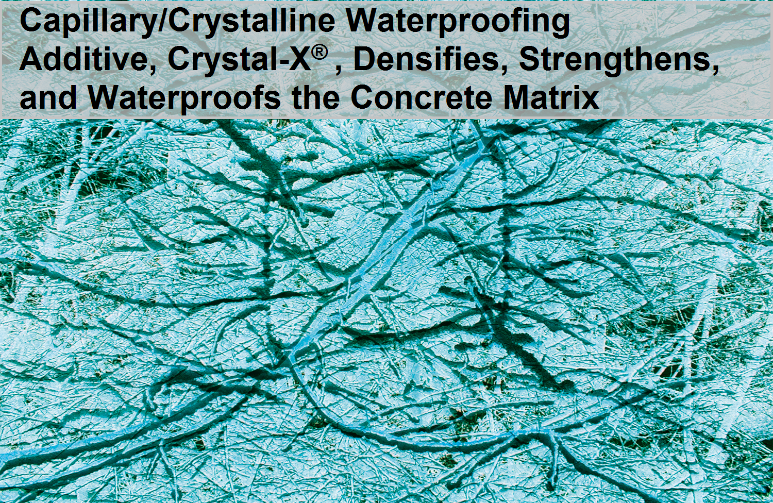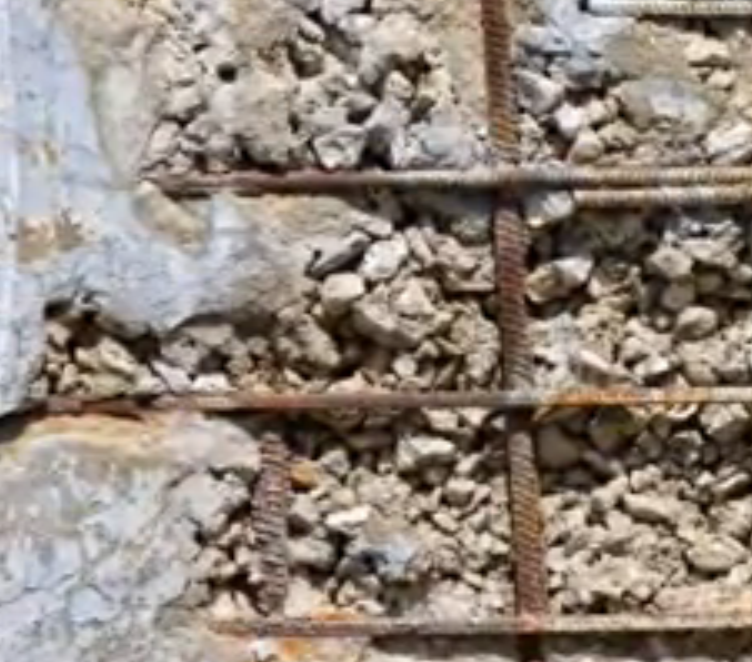The simple answer is: “they cannot be.”
Three ways that offer limited success are:
- Reduce lightly bound calcium compounds
- Reduce permeability
- Buffer the concrete with limestone / sacrificial aggregates
Pozzolans and water reducing admixtures
The use of pozzolans such as fly ash and colloidal silica, while producing concretes with excellent mechanical properties and low permeability, still feature an intrinsically rich calcium oxide based hydrate system. Pozzolans work in two ways to improve basic mechanical properties. First they are rich in amorphous silica and will react over time with the calcium hydroxide hydration by-products to form additional calcium silicate hydrates. These additional hydrates are strong, dense and offer less mobility to ions versus the watery pore space and calcium hydroxide. Secondly, they can improve the workability of concrete allowing for reduced water content. The fine rounded fly ash particles accomplish this by a combination of their size and shape. In general the benefit is not fully realized unless powerful dispersing admixtures (water reducer and superplasticizers) are employed. Many studies over the years have demonstrated that simple cement substitutions with pozzolans (and without the benefit of water reduction) only produced modest improvements. The benefits of pozzolans in general can only be appreciated when very high quality mix designs are used. Otherwise cheaper but low performing concrete will result. Ground blast furnace slag is not exactly in this class as often times the chemistry / minerology is similar to Portland cement, which is rich in calcium silicates and tricalcium aluminates. Likewise finely ground quartz silica, while beneficial over time in several ways, is not as reactive as the amorphous silica found in true pozzolans.
Permeability Reducing Additives
- Cement modifiers
Likewise there has been much work in the area of reducing permeability with additives. This has often included the combination of water reducing admixtures, cement substitutions with pozzolanic materials as mentioned above and cement modifiers such as latex and acrylic emulsions. These concepts have their applications especially where the attack is due to penetration of the hydrate structure by a mobile ion. Various chemical reactions take place with either reinforcing steel or the hydrate system and disruptive stress develops causing concrete degradation. The degradation opens more path ways and the deterioration gains pace. The use of the above mentioned modifiers was hoped to be a great boost to concrete’s chemical resistance (and to the concrete industry) but the products themselves can only tolerate dilute acids for the short term. The rich calcium based cement paste remains very reactive to the dilute acids. As noted in the industry, no knowledgeable manufacturers of these products recommend them for MIC applications today.

These in general are based on certain minerals that contain combinations of rare earth metal oxides. They promote a complex growth of solid crystals within the watery pore space of hardened Portland cement paste. They have 2 important functions; a) they can dramatically reduce the permeability of even mediocre concretes and b) the crystalline growth can continue so long as there is moisture and reactive mineral complexes available within the cement gel structure. This last point is most important for healing cracks which inevitably form in dams, tunnels, tank structures, thin linings etc. Initially, similar or better permeability reductions can be achieved with high quality mix designs featuring important use of various pozzolans in combination and very low water to binder ratios again brought about by the use of the pozzolans plus careful amounts of water reducing admixtures. Careful aggregate grading is essential to reduce the paste volume requirement and therefore keep the mix economical. Again it must be stressed that these crystalline forming additives continue to function over the life of the concrete. As explained above, there are several types of concrete deterioration that are caused by penetrating ions such as sulfate attack from sea water and de-icing salts. The crystalline forming admixtures have real value in these situations.
In recent years, there has developed some misunderstanding that these crystalline forming additives are affective against MIC. In fact some manufacturers report testing in solutions of sulfates. This again is not to be confused with corrosion from dilute sulfuric acid. Sulfate attack and MIC are two completely unrelated problems. These additives cannot change the basic chemistry of the calcium oxide rich cement structure. Keep in mind the MIC chemical attack is a surface phenomenon and not a depth attack. While permeability reductions might show some ultra-short term improvement in a concentrated clinical acidic environment, a matter of a few weeks cannot be the basis for any long term designs in the range of 25, 50 and 100 years. As an example, liquid emersion tests are typically run for say 12 weeks. During this period, control specimens based on typical OPC mortars may lose half their weight in this period. Specimens produced with mortars fortified with a crystalline forming admixture are reported as having lost only half as much. Again, this type of performance offers no logical means for a long term design necessary for municipal construction and repairs.

Sacrificial Aggregates
The concept is to use aggregates (generally just the coarse fraction) that have chemistry such that they consume some of the acid and protect the lime rich cement paste. This requires a firm understanding of many factors in a particular sewer (which can be very difficult in new construction) so that an appropriate loss rate can be calculated and then the structures wall thickness increased to compensate for the loss of concrete. In many instances the wall thickness is not increased and the life span incorrectly determined by using 100% of the base wall thickness.
In typical concretes these aggregates are generally limestone based and may contain dolomites as well. In some areas of the US these aggregates are common and others they are not. In south Florida they are common, yet corrosion in sanitary concrete structures is rampant. Thea additional alkalinity may help slow the reduction of the surface pH and thus slow the colonization of bacteria but ultimately it is just a matter of time.
A special case of this notion is with repair products based on calcium aluminate cement and very hard & reactive fused calcium aluminate aggregates. The benefit in the sewer application is due to both the improved resistance of the cement itself and then to the powerful buffering capacity of the entire mortar being rich in lime. Nevertheless, typical H2S & biological availability are enough to ultimately cause deterioration. The high cost of the raw materials combined with only an improvement (difficult to forecast and sometimes not seen at all) in life span have kept the use of these materials to a minimum. The materials are often seen to be effective in the short term of 7 to 10 years but not necessarily long enough to be judged as cost effective ultimately.

